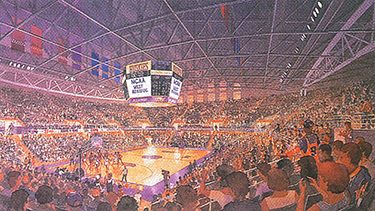Hec Edmundson Pavilion keeps its name after Seafirst gift
 Seafirst Bank has made a $5.1 million contribution to the University’s Campaign for the Student Athlete to help finance the $38 million renovation of Hec Edmundson Pavilion, the UW announced June 2.
Seafirst Bank has made a $5.1 million contribution to the University’s Campaign for the Student Athlete to help finance the $38 million renovation of Hec Edmundson Pavilion, the UW announced June 2.
Contrary to some media reports, the name honoring track coach Clarence S. “Hec” Edmundson is not being dropped. In recognition of the gift, the seating and court area of the pavilion will include the bank’s name for a period of 10 years. When it reopens after the 18-month construction project, the building will have signs that read “Seafirst Arena at Hec Edmundson Pavilion.”
“This will be tastefully done. There will be no neon signs or logos,” explains Senior Associate Athletic Director Gary Barta. The naming has been approved by the Campus Names Committee according to University policy.
The pavilion is scheduled to close in late March 1999, after the basketball season, and to reopen in November 2000 for the start of that year’s basketball schedule. As of late summer, UW officials were discussing the use of facilities at the Seattle Center for the 1999-2000 season, including Key Arena and Mercer Arena.
When Seafirst Arena at Hec Edmundson Pavilion opens, workers will have removed all support columns in the upper seating area, eliminating obstructed views that have plagued fans for 70 years. The capacity for the arena will expand to about 10,000.
In addition to its gift for the Campaign for the Student Athlete, Seafirst will also become a “gold” corporate sponsor of Husky athletics. The sponsorship will include scoreboard signage at all of the UW’s athletic venues. The combined value of the pledge and corporate sponsorship will total $9 million over the next 10 years.
The Seafirst gift provides a boost to Washington’s Campaign for the Student Athlete. With this contribution, total gifts toward the $36 million goal have exceeded $28 million.
Other capital projects on the campaign list include an indoor practice facility costing about $16 million, a new baseball/soccer field complex costing about $9 million, and renovations for the Conibear Crew House, including better dining and study facilities, at a cost of about $7 million.